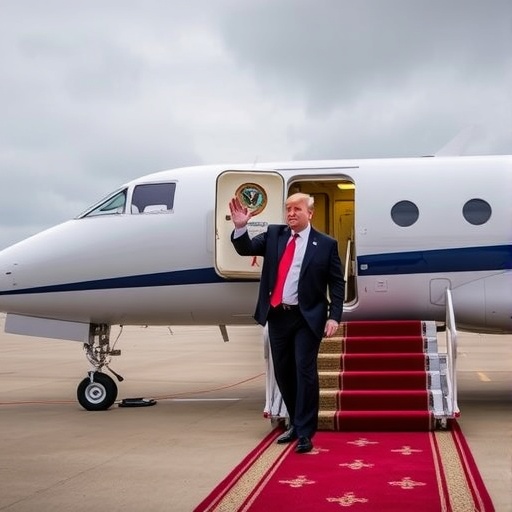Trump Administration’s $170M Luxury Jets Buy Ignites Outrage During 21-Day Government shutdown
In a move that’s fueling widespread fury across the nation, the Trump administration has greenlit the purchase of two ultra-luxurious Gulfstream G700 private jets totaling over $170 million, even as the federal Government shutdown stretches into its 21st day. This decision, defended by Homeland Security Secretary Kristi Noem, comes at a time when millions of Americans are struggling without access to essential nutrition assistance programs, highlighting stark contrasts in federal spending priorities.
- Noem’s Bold Justification for DHS’s Jet Fleet Expansion
- Shutdown’s Toll: Millions Left Hungry as Nutrition Programs Falter
- Lawmakers’ Fierce Pushback Against Escalating Federal Spending
- Unpacking the Allure and Astronomical Price Tag of Gulfstream G700s
- Future Ramifications: Will This Jet Fiasco End the Shutdown Standoff?
The announcement, buried in a Department of Homeland Security (DHS) procurement report released late Friday, has sparked immediate backlash from Democrats, advocacy groups, and even some Republicans. Critics argue that splurging on high-end luxury jets for executive travel undermines the gravity of the ongoing Government shutdown, which has left over 800,000 federal workers furloughed and delayed payments for veterans, air traffic controllers, and food stamp recipients. As the shutdown—triggered by disputes over border wall funding—drags on, this expenditure feels like a slap in the face to everyday Americans facing financial hardship.
Secretary Noem, a staunch Trump ally and former South Dakota governor, took to the podium at a DHS briefing on Monday to justify the purchase. “These aircraft are essential for rapid response in national security operations,” she stated firmly. “In an era of escalating threats, we cannot afford to compromise on tools that protect our borders and citizens.” But her words have done little to quell the storm of criticism, with social media erupting in memes and hashtags like #JetsOverJobs and #ShutdownSplurge.
Noem’s Bold Justification for DHS’s Jet Fleet Expansion
Homeland Security Secretary Kristi Noem didn’t mince words when addressing the controversy surrounding the luxury jets acquisition. During a press conference at DHS headquarters in Washington, D.C., she outlined the strategic necessity behind the $170 million investment. “The Gulfstream G700s represent the pinnacle of aviation technology, offering unmatched range, speed, and security features vital for DHS missions,” Noem explained. Each jet, capable of flying non-stop from New York to Tokyo at speeds up to Mach 0.925, is equipped with advanced surveillance systems, reinforced cabins, and state-of-the-art communication arrays—features Noem claims are indispensable for counterterrorism and disaster response operations.
The purchase was initiated through a competitive bidding process under the Federal Acquisition Regulation, with Gulfstream Aerospace selected for its proven track record in outfitting government fleets. According to DHS documents obtained by investigative journalists, the contract includes not just the aircraft but also maintenance packages, pilot training, and hangar upgrades at key facilities like Joint Base Andrews. The total cost breaks down to approximately $85 million per jet, a figure that includes custom modifications for secure data links and anti-missile defenses.
Noem emphasized that the decision predates the current government shutdown, with negotiations finalized in late December. “This isn’t about extravagance; it’s about preparedness,” she insisted, pointing to recent border security challenges and the need for swift executive transport amid global uncertainties. However, transparency advocates question why the deal wasn’t paused or reevaluated during the fiscal impasse, especially when federal spending on non-essential items is under intense scrutiny.
Supporting Noem’s stance, a DHS spokesperson provided additional context in a statement to reporters: “Our previous fleet, including aging models from the 1990s, has become unreliable for long-haul missions. Delaying this upgrade could jeopardize operational efficiency.” Yet, internal memos leaked to the press reveal that alternative, more cost-effective options—like leasing or refurbishing existing planes—were considered but ultimately rejected in favor of the new luxury jets.
Shutdown’s Toll: Millions Left Hungry as Nutrition Programs Falter
While DHS pours millions into luxury jets, the government shutdown is exacting a heavy toll on vulnerable populations. The U.S. Department of Agriculture (USDA), operating on skeleton staffing, has halted processing for the Supplemental Nutrition Assistance Program (SNAP), commonly known as food stamps. An estimated 40 million low-income Americans rely on SNAP, and with the shutdown now in its third week, states are warning of delays in benefit distribution that could leave families without groceries by mid-February.
Statistics paint a grim picture: The Center on Budget and Policy Priorities reports that over 9 million children in SNAP households are at risk of missing meals, exacerbating food insecurity rates that have already climbed 5% since the shutdown began. In states like California and Texas, food banks are overwhelmed, with demand surging 30% according to Feeding America. “We’re seeing lines out the door—people who never thought they’d need help are now desperate,” said nonprofit director Maria Gonzalez in an interview from Los Angeles.
The ripple effects extend beyond nutrition. Furloughed federal employees, numbering 800,000, are dipping into savings or relying on food pantries to make ends meet. Air traffic controllers, working without pay under the guise of “essential” status, report burnout and errors, raising aviation safety concerns. Veterans Affairs hospitals are delaying non-emergency care, and national parks remain closed, costing local economies billions in lost tourism revenue.
Congressional Democrats have seized on these hardships to lambast the administration’s priorities. House Speaker Nancy Pelosi tweeted, “While families go hungry, the Trump team buys private jets? This is federal spending at its most tone-deaf.” Advocacy groups like the National Women’s Law Center have launched petitions demanding an immediate end to the shutdown, gathering over 500,000 signatures in 48 hours.
- Key Impacts: 40 million SNAP users affected; 800,000 furloughed workers; $11 billion estimated economic loss per week.
- Regional Hotspots: Southern states hit hardest by delayed disaster aid; urban areas strained by food bank overloads.
- Long-Term Risks: Potential for increased child malnutrition and homelessness if shutdown persists.
Lawmakers’ Fierce Pushback Against Escalating Federal Spending
The luxury jets controversy has ignited a bipartisan firestorm in Congress, with lawmakers from both sides decrying the administration’s federal spending decisions amid the government shutdown. Senate Minority Leader Chuck Schumer called the purchase “an outrageous misuse of taxpayer dollars,” vowing to introduce legislation that would require congressional approval for all DHS acquisitions over $50 million during fiscal emergencies.
On the Republican side, even fiscal hawks like Sen. Rand Paul expressed unease. “I’m all for strong borders, but $170 million on jets while our people suffer? That’s not conservative governance,” Paul said in a Fox News appearance. The Senate Budget Committee has scheduled emergency hearings for next week, where Kristi Noem is expected to testify. Committee chair Sen. Mike Enzi has promised a deep dive into DHS procurement practices, potentially uncovering other questionable expenditures.
House Oversight Committee investigations are already underway, with Chairman Elijah Cummings subpoenaing records related to the jet deal. “This isn’t just about planes; it’s about accountability in how we spend during crises,” Cummings stated. Preliminary findings suggest the contract may have bypassed standard cost-benefit analyses, raising red flags about influence from defense contractors with ties to the administration.
Public opinion polls reflect the growing discontent. A new Quinnipiac University survey shows 62% of Americans disapprove of the jet purchase, with 78% of Democrats and 51% of independents viewing it as insensitive. Social media amplifies these voices: Viral videos of furloughed workers protesting outside the White House contrast sharply with glossy ads for the Gulfstream G700, which boasts leather interiors and whisper-quiet cabins.
- Bipartisan Bills: Proposals to cap executive travel budgets during shutdowns.
- Whistleblower Concerns: DHS insiders alleging rushed approvals to beat shutdown deadlines.
- Comparative Waste: Past scandals, like the Pentagon’s $435 hammer, pale in comparison to this scale.
Unpacking the Allure and Astronomical Price Tag of Gulfstream G700s
At the heart of the scandal are the Gulfstream G700s themselves—flagship luxury jets that redefine private aviation opulence. Manufactured by General Dynamics’ Gulfstream subsidiary, these behemoths feature a cabin spanning 56 feet with customizable layouts, including private staterooms, conference rooms, and full galleys. Priced at $75 million base per unit, the DHS versions balloon to $85 million each after government-specific upgrades like encrypted comms and ballistic protection.
Why such extravagance for DHS? Officials cite the need for global reach: The G700’s 7,500-nautical-mile range allows direct flights to hotspots like the Middle East or Asia without refueling, crucial for rapid deployment of border agents or intelligence teams. Fuel efficiency is another selling point—20% better than predecessors—potentially saving on long-term operational costs. Yet, critics counter that commercial charters or military transports could suffice at a fraction of the price.
Historical precedents abound. The Obama-era Air Force One upgrades cost $3.2 billion, but those were for presidential use with rigorous justifications. Under Trump, similar DHS expansions have drawn scrutiny; a 2018 report by the Government Accountability Office flagged $2.5 billion in unchecked homeland security spending. The current deal, part of a broader $78 billion DHS budget request, underscores ongoing debates over militarizing domestic agencies.
Industry experts weigh in with mixed views. Aviation analyst Richard Aboulafia noted, “These jets are overkill for most DHS needs, but in a post-9/11 world, security paranoia drives such investments.” Meanwhile, taxpayer watchdogs like Citizens Against Government Waste estimate the jets could fund SNAP benefits for 200,000 families for a year, fueling the narrative of misplaced priorities.
Future Ramifications: Will This Jet Fiasco End the Shutdown Standoff?
As the government shutdown enters uncharted territory—the longest in U.S. history—the luxury jets debacle could prove a tipping point. White House negotiators are under mounting pressure to compromise on border funding, with reports of internal GOP fractures over the spending optics. President Trump, in a weekend tweetstorm, defended Kristi Noem and DHS, calling critics “fake news peddlers” but hinting at willingness for a short-term deal to reopen government.
Looking ahead, the scandal may trigger sweeping reforms. Bipartisan talks are advancing on a bill to impose spending freezes during shutdowns, potentially saving billions in future fiscal dramas. For DHS, the jets’ delivery—slated for late 2020—faces delays if Congress withholds funding. Legal challenges from watchdog groups could tie up the contract in courts, forcing a reevaluation.
Economists predict prolonged shutdown effects: A Moody’s Analytics study warns of a 0.3% GDP hit per week, with recession risks if it extends to March. For American families, the human cost looms largest—delayed tax refunds, crumbling infrastructure inspections, and strained social services. As Noem and her team navigate the backlash, the nation watches to see if this aerial extravagance grounds the administration’s agenda or propels calls for change.
In the broader landscape of federal spending, this episode serves as a cautionary tale. With midterm elections looming and public trust in government at lows, the Trump team must recalibrate. Will they pivot to empathy-driven policies, or double down on security imperatives? The skies ahead are turbulent, much like the jets they’ve chosen to fly in.









